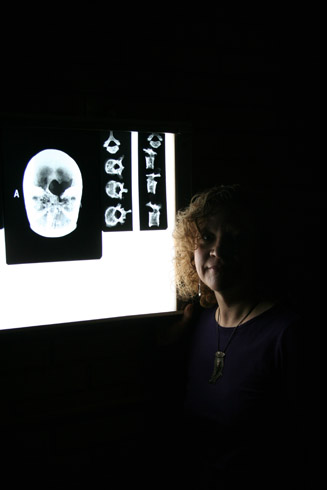 University of Alberta professor of anthropology Sandra Garvie-Lok is on a CSI-style hunt for answers to a 1,500-year-old crime. Her victim: John Doe, an unidentified male with severe cranial trauma, killed at the ancient Greek city of Nemea during the Slavic invasion of Greece in the 6th century AD. The verdict: murder, most likely but how and why?
University of Alberta professor of anthropology Sandra Garvie-Lok is on a CSI-style hunt for answers to a 1,500-year-old crime. Her victim: John Doe, an unidentified male with severe cranial trauma, killed at the ancient Greek city of Nemea during the Slavic invasion of Greece in the 6th century AD. The verdict: murder, most likely but how and why?
Robbery has already been ruled out the unfortunate soul, whose cadaver was discovered crushed in a small, graffiti-stained tunnel entrance, had cash and other possessions on him. Was he perhaps slain in battle, seeing as he appears to have been an eye-witness to the merciless Slavic attack on the Byzantine Greek city? Possibly, but he doesnt appear to have been a soldier rather, Doe was a poor peasant farmer who either caught an unlucky blow as the slaughter raged around him or was left with no other choice but to take up arms and desperately join the fight to defend his home.
Its a tough case to crack, and will probably never be solved. But its just the kind of challenge that anthropological investigator like Garvie-Lok a specialist in osteology, the study of bones thrives upon.
This kind of connection to peoples lives is why I got into this, she said, in a University of Alberta press release. I really do feel while Im studying the bones that Im touching someone elses life, Im reaching out to the past. Thats why I like this job.
A Terrifying and Brutal End
Invasions of the Greek peninsula in the 5th and 6th centuries AD by barbarian tribes saw the Greek provinces of the Byzantine Empire rocked by an orgy of violence, rape and pillaging. Slavs, Eurasian peoples who spread across the continent from their Central and Eastern European homelands roughly after the 5th century BC, and Avars, another group of nomadic eastern European peoples possibly of Asian origin, were especially nasty.
The Slavs and Avars were pretty brutal, said Garvie-Lok, who was called in to examine her deceased subject by a University of California, Berkeley team who have been working at Nemea since 2004.
It must have been sheer terror that led Doe to end his days squeezed into such a sorry hovel. If he was hiding in that unpleasant place, added the anthropologist, whose findings were recently published in the International Journal of Historical Archaeology, he was probably in a lot of danger. So, he hid out, but he didnt make it.
Yet, evidence namely the few coins and other possessions Doe was carrying suggests that he perhaps wasnt purely acting in desperation, but may have been acting quite rationally.
It was common in Greece when things fell apart like this for people to bury coins under a rock or inside a wall, hoping that whoever was coming through wouldnt find it and maybe they could collect the coins and move on after things calmed down. Of course, things didnt calm down for this guy.
Gallop-By Spearing or Last Ditch Defence?
The potential for deriving clues as to how and why a person died from centuries-old human remains have been well-proven recently by CT-scan investigations on the mummy of King Tut. They delivered the convincing verdict that Egyptian pharaoh Tutankhamun was killed by an infection (sickle-cell disease specifically, according to the latest research) to a wound sustained days before his death.
While the head injury the Nemea tunnel victim sustained was serious, it wasnt the fatal blow well never know which wound killed him. Likewise, we can never be certain as to the circumstances under which it was struck. It may have been simple bad luck a gallop-by spearing, and a case of wrong place, wrong time, as Garvie-Lok puts it or the inevitable fate of an amateur fighter engaged in a last ditch struggle.
It was unusual for leaders of the Byzantine Empire to conscript, which suggests that if Doe did take up arms, it was because it was the only option he had to protect his family, possessions and community. Or he was pressed into service because everything was just going south, we cant be sure, says Garvie-Lok.
 Either way, that he was hiding with his possession when he died is a pretty clear reflection that, for him, his world was ending.
Either way, that he was hiding with his possession when he died is a pretty clear reflection that, for him, his world was ending.
Open Verdict
There wont be any suspect, trial and conviction at the conclusion of this case. Not simply because of the obvious fact that the killer also perished many centuries ago, but also because no anthropologist investigating a historic death can ever reach a conclusion with any certainty.
As viewers of TV cop shows such as The Wire or CSI will well know, two things are vital to a homicide being solved a fresh, uncontaminated crime-scene, and the option of questioning a suspect and forcing them into a confession. Neither, of course, are possible in Garvie-Loks investigation.
She dislikes the forensic cop show comparison the whole weve-got-the-answer-in-12-hours thing as she puts it and cautions that her work is much more laborious and time-consuming. A clear-cut, open and shut verdict is never going to lie at the end of a trail of clues just a stack of probabilities.
In this job, youre always talking about likelihoods, she said. Until we develop a time machine, we cant go back and know for sure.